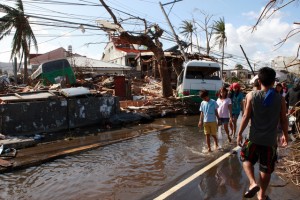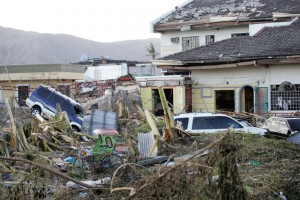Typhoon Haiyan diary 2: Emergency aid makes it way to hardest hit areas
2013-11-11
By Christopher de Bono, Regional Chief of Communication, UNICEF East Asia and Pacific
As emergency relief begins to reach communities in the Philippines devastated by Typhoon Haiyan, a clearer picture emerges of just how much more is needed.

|
MANILA, Philippines/ HONG KONG, 11 November 2013 – It’s day four since Typhoon Haiyan – known here as Yolanda – hit the Philippines, and the good news is that aid is getting through. I’m proud to say that UNICEF’s water and sanitation supplies are now in Tacloban, where they will help prevent the much-feared outeaks of typhus and cholera. The bad news is that not enough aid is getting through. Despite the tireless efforts of the Government and the army and all my colleagues in the aid community, we are still not reaching everyone in dire need. |
Logistics have been the key to the first days. The damage to the local infrastructure is enormous. The typhoon has blocked or destroyed roads, idges and airports, and the authorities have been working feverishly to open the routes needed to get supplies where they need to go.

|
The level of devastation, the continued bad weather and the challenging terrain of the central Philippines have made this a tough ask. Slowly they have succeeded. But by the time routes were opened and aid groups could get water, food, shelter and medicines in, people were already hungry and desperate. Unaware of everything being done to reach them – no surprise, given that Haiyan demolished communications networks – people felt deserted and hopeless. So as soon as roads were open, everyone who was able to gathered their children and took to the roads out of the city, or headed for the airport in hopes of getting a flight out. Who can blame them? Unfortunately, after the routes were painstakingly cleared of obstacles to allow desperately needed aid to get in, they were suddenly blocked again with desperate, hungry and tired people trying to get out. For all the difficulties, aid is making its way to where it needs to go – in trickles, but trickles can become floods. |

|
We are also slowly improving our understanding of what is needed, and increasing our capacity to provide it. UNICEF teams are spreading throughout the affected parts of the country, assessing children’s needs and starting to meet them. Colleagues are in all the eastern areas working hard. It’s not difficult to understand why people who have lost everything else are now losing hope. But from the vantage point of where I am at present, I am starting to see a little glimmer of light. Just a glimmer. Until every child is safe, that’s not enough. And we are working around the clock with that one simple purpose. |
Donate NOW to help the children of the Philippines |









